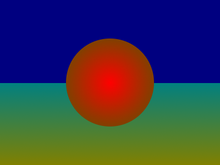- ChromaDepth
-
Chromadepth is a patented system from the company Chromatek (a subsidiary of American Paper Optics since 2002) that produces a stereoscopic effect based upon differences in the diffraction of color through a special prism-like holographic film fitted into glasses. Chromadepth glasses purposely exacerbate chromatic aberration and give the illusion of colors taking up different positions in space, with red being in front, and blue being in back. This works particularly well with the sky, sea or grass as a background, and redder objects in the foreground.
Any media piece can be given a 3D effect as long as the color spectrum is put into use with the foreground being in red, and the background in blue. From front to back the scheme follows the visible light spectrum, from red to orange, yellow, green and blue. As a result, ChromaDepth works best with artificially produced or enhanced pictures, since the color indicates the depth. Unlike anaglyph images or polarization, creating real-life ChromaDepth pictures without manual enhancement is practically impossible, since cameras cannot portray true depth; most other 3D schemes use the concept of stereopsis, which only simulates depth. However, this also gives ChromaDepth images a distinct advantage: unlike stereopsis-based schemes that require two images, ChromaDepth contains depth information in one image, which eliminates the ghosting seen in other schemes when one attempts to view them without 3D glasses. Thus, ChromaDepth images can be viewed comfortably and legibly without glasses, even though the 3D effect will not be perceivable without them.
The ChromaDepth system helped bring the haunted attraction industry to new heights when popular attractions such as Netherworld Haunted House in Atlanta, GA began using the technology in the late 1990's and early 2000's. The system was used variously for comic-books, educational books for children, light show displays at such planetariums as the Hayden Planetarium in New York City, amusement park "black light" attractions, and other printed and projected applications. This method was also used for I Love the '80s 3-D and glasses could be bought at Best Buy. Chromadepth has recently been put into use in Crayola's 3D Chalk. This technique was also used by the production company Quirky Motion for the music video promoting New Cassettes 2007 single "recover/retreat" as part of the BBC Electric Proms [1]See also
References
ChromaDepth images
Technologies ChromaDepth · Head-mounted display · LC shutter glasses · Lenticular printing · Polarized 3D glasses · Stereo camera · Tru-Vue · View-Master · Virtual retinal displayPerception Types of products 3-D film · 3D television · 3D-enabled mobile phones · Anaglyph image · Autostereogram · Spot the difference · StereoautographCategories:- 3D imaging
- Technology stubs
Wikimedia Foundation. 2010.

